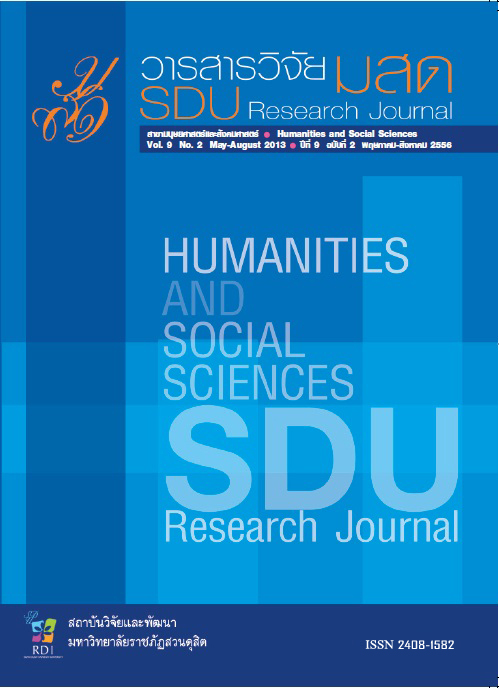การพัฒนารูปแบบการเฝ้าระวังทางวัฒนธรรมสำหรับโรงเรียนมัธยมศึกษาในชุมชน
Keywords:
การเฝ้าระวังทางวัฒนธรรม, โมเดลความสัมพันธ์เชิงสาเหตุ, โรงเรียนมัธยมศึกษาในชุมชนAbstract
บทคัดย่อ
งานวิจัยครั้งนี้เป็นการวิจัยเชิงผสมผสาน มีวัตถุประสงค์เพื่อ 1) ศึกษาผลกระทบทาง
วัฒนธรรมจากการเปลี่ยนแปลงทางสังคมของชุมชน 2) พัฒนาโมเดลความสัมพันธ์เชิงสาเหตุปัจจัยทางสังคมที่ส่งผลกระทบต่อวัฒนธรรมชุมชนจากการเปลี่ยนแปลงทางสังคม และ 3) พัฒนารูปแบบการ เฝ้าระวังทางวัฒนธรรมสำหรับโรงเรียนมัธยมศึกษาในชุมชนจากผลกระทบทางวัฒนธรรมจากการเปลี่ยนแปลงทางสังคมของชุมชน กลุ่มตัวอย่าง แบ่งเป็น 2 กลุ่ม คือ กลุ่มที่ 1 การศึกษาเชิงปริมาณ ประกอบด้วยผู้แทนชุมชน ผู้ที่รับผิดชอบงานด้านวัฒนธรรมของโรงเรียน วัฒนธรรมจังหวัด และวัฒนธรรมอำเภอซึ่งได้มาจากการสุ่มแบบหลายขั้นตอน ภาคละ 4 จังหวัด รวม 16 จังหวัด ได้จำนวนตัวอย่างรวม 800 คน เครื่องมือที่ใช้ในการเก็บข้อมูลเป็นแบบสอบถามแบบประมาณค่า 5 ระดับ ที่ผู้วิจัยสร้างขึ้น และกลุ่มที่ 2 การศึกษาเชิงคุณภาพ เลือกโรงเรียนในชุมชน 1 โรงเรียน ที่ผู้บริหาร ครู นักเรียน ผู้ปกครอง และผู้ที่เกี่ยวข้องให้ความร่วมมือในการดำเนินการเฝ้าระวังทางวัฒนธรรมและชุมชนให้ความร่วมมือ เครื่องมือที่ใช้เก็บข้อมูลเป็นแบบสัมภาษณ์แบบมีโครงสร้างและแบบสังเกต การวิเคราะห์ข้อมูลใช้โปรแกรม SPSS วิเคราะห์ค่าสถิติพื้นฐาน ค่าสัมประสิทธิ์สหสัมพันธ์ระหว่างตัวแปรสังเกตได้ ใช้โปรแกรมLISREL 8.72 วิเคราะห์โมเดลความสัมพันธ์เชิงสาเหตุปัจจัยทางสังคมที่ส่งผลกระทบต่อวัฒนธรรมชุมชน และทำการวิเคราะห์ข้อมูลเชิงคุณภาพด้วยวิธีการวิเคราะห์เนื้อหา ผลการวิจัยพบว่า 1) ผลกระทบทางวัฒนธรรมจากการเปลี่ยนแปลงทางสังคมของชุมชน ปัจจัยที่ส่งผลกระทบทางบวกกับวัฒนธรรมในชุมชน ได้แก่ ปัจจัยทางจิตวิทยา ปัจจัยทางสังคม ปัจจัยทางการเมือง ปัจจัยด้านประชากร และปัจจัยทางศาสนา ส่วนปัจจัยที่ส่งผลกระทบทางลบกับวัฒนธรรมในชุมชน ได้แก่ ปัจจัยทางการสื่อสาร นวัตกรรม และเทคโนโลยี ปัจจัยทางภูมิศาสตร์ และสภาพแวดล้อมทางธรรมชาติ ปัจจัยทางเศรษฐกิจ และปัจจัยทางการศึกษา 2) โมเดลความสัมพันธ์เชิงสาเหตุปัจจัยทางสังคมที่ส่งผลกระทบต่อวัฒนธรรมชุมชนจากการเปลี่ยนแปลงทางสังคม พบว่า โมเดลมีความสอดคล้องกับข้อมูลเชิงประจักษ์อยู่ในเกณฑ์ดี ผลการทดสอบไค-สแควร์ มีค่าเท่ากับ11118.82 ค่า p-value เท่ากับ 0.00 ที่องศาอิสระเท่ากับ 6238 ค่า/ df เท่ากับ 1.78 ค่า CFI เท่ากับ 0.98 ค่า RMSEA เท่ากับ 0.031 ตัวแปรทั้งหมดในโมเดล สามารถอธิบายความแปรปรวนของวัฒนธรรมชุมชน ได้ร้อยละ 61 ปัจจัยที่มีอิทธิพลทางตรงต่อวัฒนธรรมชุมชนมี 5 ตัวแปร คือ ปัจจัยทางภูมิศาสตร์และสภาพแวดล้อมสภาพแวดล้อมทางธรรมชาติ ปัจจัยทางเศรษฐกิจ ปัจจัยทางสังคม ปัจจัยทางจิตวิทยา และปัจจัยทางการเมือง 3) รูปแบบการเฝ้าระวังทางวัฒนธรรมสำหรับโรงเรียนมัธยมศึกษาในชุมชนเป็นรูปแบบเชิงระบบบนฐานของข้อค้นพบจากวิธีการเชิงปริมาณ ประกอบด้วย 4 ขั้นตอน คือ (1) กำหนดขอบเขตและบทบาทของโรงเรียนในการเฝ้าระวังทางวัฒนธรรมที่ชุมชนคาดหวังหรือกำหนด (2) ผู้บริหารโรงเรียนทำความเข้าใจกับครู นักเรียนและผู้ปกครอง (3) กำหนดแผนปฏิบัติการเฝ้าระวังทางวัฒนธรรมของโรงเรียน และ (4) การดำเนินการตามแผนปฏิบัติการ
คำสำคัญ: การเฝ้าระวังทางวัฒนธรรม โมเดลความสัมพันธ์เชิงสาเหตุ โรงเรียนมัธยมศึกษาในชุมชน
Abstract
The study aimed to: 1) investigate cultural effects of social changes in communities, 2) develop a causal relation model of social factors which affected social culture relating to social changes, and 3) develop the model of cultural surveillance for secondary schools affected by cultural and social changes. A mixed-method research design was applied for quantitative and qualitative data collection. A multistage random sampling technique was employed for participant selection. There were 2 groups of participants: one for quantitative data collection, and the other for qualitative data source. The first group consisted of 800 participants derived from 16 provinces in Thailand (4 provinces in each region). This included community representatives andpersons in charge of cultural activities in schools, districts, as well as provinces.
The researcher constructed a 5-rating scale questionnaire and distributed it to the first group for data collection. The second participant group assigned to the qualitative study was comprised of schools stakeholders including administrators, teachers, students, parents, and other stakeholders who ran the cultural surveillance in cooperation with the communities. Structured interview and observation forms were used to collect qualitative data. Basic statistics and correlation coefficients between observed variables were employed for quantitative data analysis, including Statistical Package for the Social Sciences (SPSS for Windows). The LISREL 8.72 program was applied for data analysis regarding the cause-effect relation model. Content analysis technique was employed for qualitative data. Findings were as follows:
1. For cultural effects relating social changes, psychological, social, political, and religious factors carried out positive effects. On the other hand, communication, innovation and technology, geography and natural environment, economy, and educational factors provided negative effects.
2. The cause-effect relation model was well-consistent with empirical data, as c2 =11118.82,p = .000, df = 6238, c2/df = 1.78, Comparative Fit Index (CFI) = 0.98, Root Mean Square Error of Approximation (RMSEA) = 0.031. All variables explained the variance of the community culture at 61%. Five factors affected directly on the community culture were geography and natural environment, economy, social, psychological, and political.
3. Based on the qualitative study, there were 4 steps for basic forming of the surveillance. They were: 1) identifying scopes and roles of the schools for cultural surveillance concerning the community expectation, 2) clarifying the scopes and the roles with stakeholders, 3) conducting an action plan for the surveillance, and 4) implementing the plan.
Keywords: cultural surveillance, cause relation model, local public secondary school







